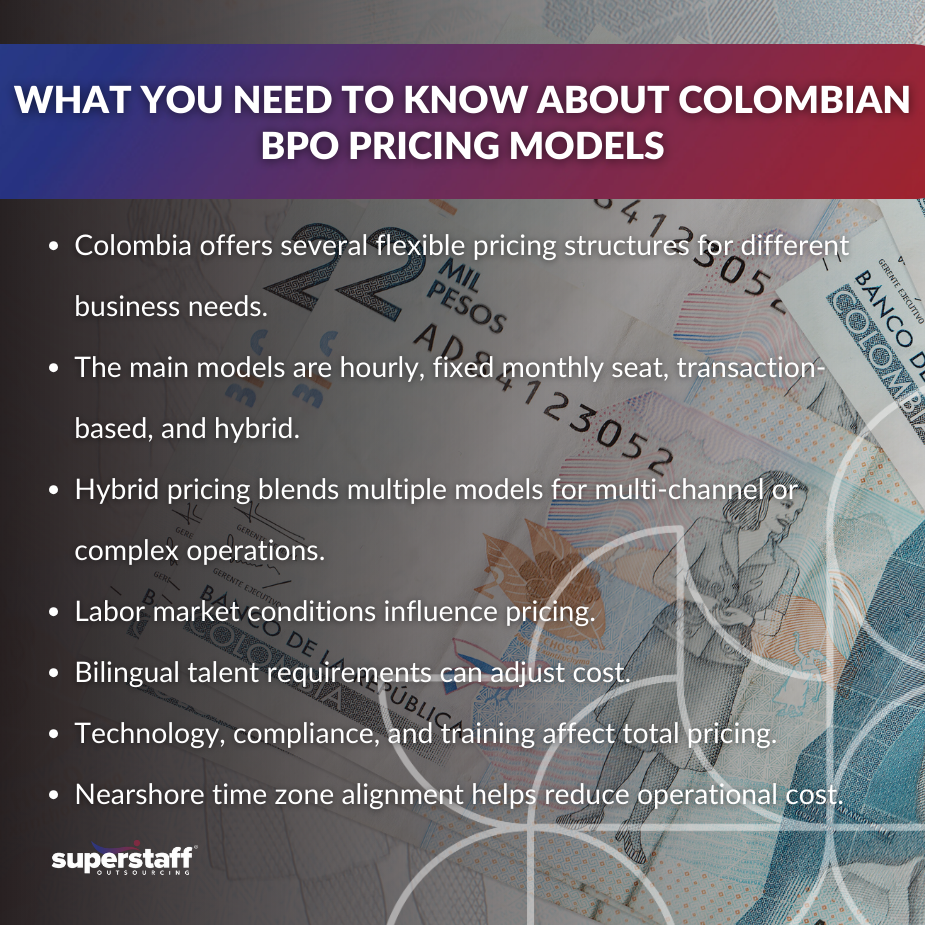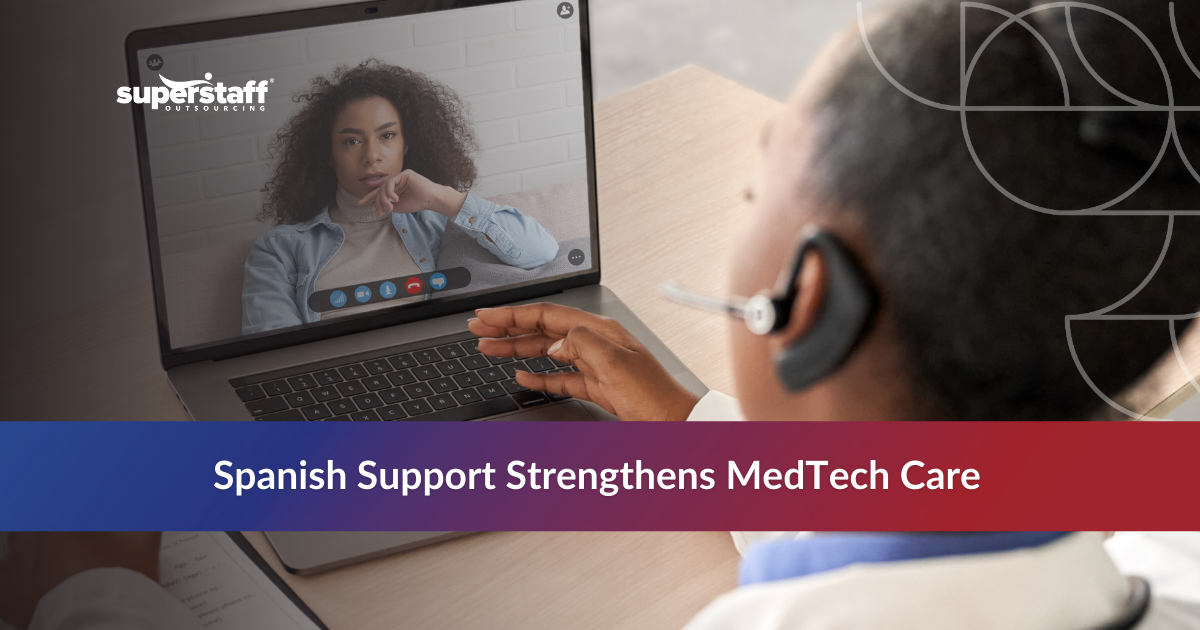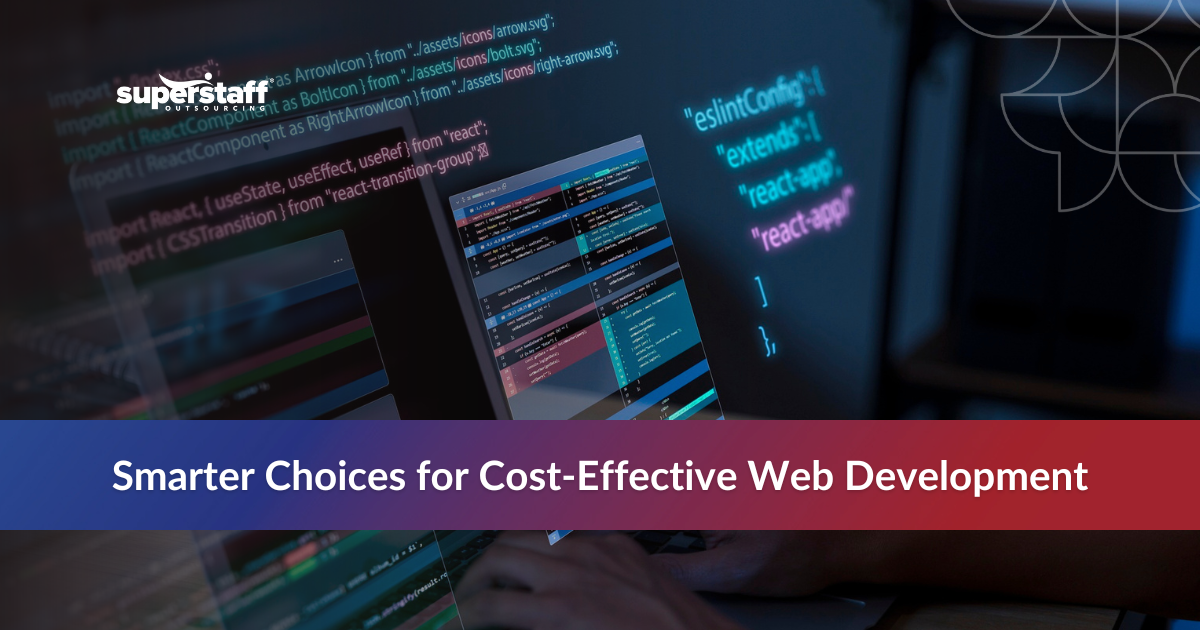
Colombia has become one of the fastest-growing destinations for outsourced customer service, back-office operations, tech support, and multilingual CX. Nearshore alignment, bilingual talent, and cultural familiarity with U.S. consumers make the country an appealing choice for companies looking to strengthen operations without overspending. But for most decision-makers, one question matters before anything else: How much does BPO cost in Colombia?
That answer depends on understanding the different Colombian BPO pricing models and how each one fits different business needs. When companies know how Colombian providers structure their rates, it becomes easier to evaluate vendors, map outsourcing budgets, and plan long-term capability building.
This blog breaks down the key pricing structures U.S. businesses encounter, the factors that influence them, and how leaders can choose the right model for their service requirements.
The Rise of Colombia as a Nearshore Outsourcing Hub
Colombia’s outsourcing sector has matured rapidly over the past decade. The country is now widely recognized for its bilingual customer service talent, strong English proficiency, CX culture, and skilled workforce across finance, tech support, healthcare support, and logistics.
But its growth is also tied to something else: a transparent and flexible cost structure that appeals to SMEs and midmarket companies who want enterprise-grade support without the inflated price tag. As Colombia outsourcing pricing becomes increasingly competitive, more global brands are taking notice.
However, to make informed decisions, companies must look beyond marketing claims and understand what drives BPO costs in Colombia. That starts with exploring the various Colombian BPO pricing models in detail.
The Hourly Rate Model
The hourly rate model is one of the most familiar structures for companies new to outsourcing. In this setup, businesses pay a fixed hourly rate for each agent working on their account. Although simple, this model offers a high degree of transparency and can be ideal for dynamic environments.
Hourly billing within Colombian BPO pricing models works particularly well for projects that require:
- Variable workloads
- Short-term or seasonal support
- Pilot projects
- Testing new service lines before scaling
Because businesses only pay for the exact hours worked, the hourly model helps maintain strong budget visibility. It’s also useful for companies that want more control while gradually building trust with their outsourcing partner.
However, the model does require careful scope monitoring. If volumes spike unexpectedly or calls take longer, total spending may exceed initial projections. Still, for companies asking “how much does BPO cost in Colombia” for flexible operations, hourly pricing remains one of the most predictable options.

The Fixed Monthly Seat Model
Among all Colombian BPO pricing models, the fixed monthly seat model is the most widely adopted—especially among U.S. midmarket companies. In this structure, companies pay a flat monthly fee per agent that includes everything needed for full operations.
A typical fully loaded seat in Colombia includes:
- Base salary
- Mandatory benefits
- Taxes and labor compliance
- Workstations and office space
- Tools and software
- Team leads and supervisory support
- Quality assurance and performance monitoring
- HR and administrative support
The beauty of the seat model is predictability. Companies know exactly what they will pay each month, making budgeting and planning straightforward. It creates an “owned team” feel, even though the agents are technically offshore employees.
This structure works especially well for:
- Customer service
- Technical support
- Accounting support
- Healthcare back-office operations
- Logistics coordination and freight support
- E-commerce operations
The fixed seat model is the cornerstone of competitive Colombian BPO pricing for U.S. businesses because it removes guesswork and provides long-term operational stability.
One consideration: companies must ensure transparency in what is included. Some providers offer a low monthly rate but exclude essential items such as QA, training, workforce management, or weekend staffing—creating hidden costs. Working with reputable vendors solves this problem.
The Transaction-Based Model
For businesses with high-volume, measurable tasks, a transaction-based pricing model can be incredibly efficient. Instead of paying hourly or per seat, companies pay based on output. This model is commonly used for:
- Claims processing
- Content moderation
- Order fulfillment
- Lead verification
- Data entry
- Ticket resolution
- Email support
Transaction-based pricing aligns spending directly with performance. You pay for exactly what gets done—no more, no less. For companies comparing “how much does BPO cost in Colombia” across multiple vendors, this structure often feels the most tangible and data-driven.
The advantage is scalability. As your transaction volume grows, the rate becomes more cost-efficient. It’s also easier to calculate ROI and measure productivity by linking cost to completed tasks.
However, this model requires very clearly defined SLAs. Without clarity on complexity tiers, handling times, or exceptions, there is potential for misalignment. With a well-defined scope, though, transaction-based pricing becomes one of the most efficient Colombian BPO pricing models for predictable workflows.
The Hybrid Pricing Model
Many companies operate across multiple channels and require more than one pricing structure. That’s where the hybrid model comes in.
Hybrid pricing combines hourly, seat-based, and transaction-based models based on the nature of each task. For example:
- A logistics company may pay hourly for customer calls, per-transaction for shipment updates, and fixed seat rates for supervisors.
- A healthcare provider may pay per claim processed but use a fixed seat model for prior authorization teams.
- An e-commerce brand may combine per-chat pricing for overflow with fixed seats for its core team.
Hybrid pricing is the most adaptable option among Colombian BPO pricing models, allowing businesses to maximize value across different tasks. It also gives companies the flexibility to scale certain tasks while keeping others stable.
The primary requirement is strong communication. The outsourcing partner must proactively monitor performance, adjust workloads, and ensure accurate billing across all pricing channels.
Key Cost Factors That Influence BPO Pricing in Colombia
Understanding the pricing models is only part of the picture. The second piece is knowing what influences BPO costs in Colombia.
Here are the biggest factors that shape pricing:
Labor Market Conditions
Colombia offers a competitive talent pool, with strong bilingual proficiency in Bogotá, Medellín, Cali, and Barranquilla. Labor availability and salary expectations can vary by region, affecting the final price.
Bilingual Talent Requirements
Spanish-English bilingual agents command higher rates, but the value they bring—especially for U.S. brands targeting Hispanic customers—is unmatched.
Operating Hours and Shift Types
Overnight or weekend coverage may influence pricing. Fortunately, Colombia’s time zone alignment with the U.S. reduces the need for graveyard shifts.
Technology and Tooling
If the BPO provides tools (CRM, dialers, QA platforms), these add to the total cost. However, many Colombian providers bundle them into seat rates for convenience.
Training and Ramp-Up Complexity
Industry-specific operations—healthcare, tech, finance, logistics—require deeper training investments.
Regulatory and Compliance Requirements
HIPAA, PCI DSS, or SOC 2 compliance adds operational cost but ensures business-grade protection.
Management Structure
Strong supervision, QA frameworks, and workforce optimization directly influence team performance and pricing.
These factors shape the exact number for “how much does BPO cost in Colombia,” but the overall cost advantage remains clear: Colombian pricing is significantly lower than U.S., Canada, and Western Europe, without sacrificing quality.
How to Choose the Right Pricing Model
Selecting the right structure from the available Colombian BPO pricing models depends on clear alignment between your business operations and budget strategy.
Here’s how leaders can make the best choice:
1. Evaluate Your Volume Stability
If your operations run consistently, the fixed seat model is ideal. If your volume fluctuates, consider hourly or transaction-based options.
2. Map Your Tasks
Which tasks require ongoing human handling? Which can be measured? Which need supervision? Mapping these questions helps match models to functions.
3. Understand Your Long-Term Growth Plans
If you plan to scale aggressively, hybrid pricing gives the most flexibility.
4. Review Vendor Inclusions and Exclusions
Avoid providers who hide costs behind low headline rates. Look for transparent pricing tables and detailed breakdowns.
5. Prioritize Partners With Strong Management Layers
A better-managed team often leads to higher productivity and lower long-term costs—regardless of the pricing model.
6. Choose Models That Fit Your Metrics
For companies heavily focused on CSAT, handle time, or accuracy, fixed seat or hourly models might work best. For task-oriented operations, transaction-based billing is more logical.
7. Consider Total Value, Not Just Base Price
Cheaper does not always mean better. Ensure your chosen model supports quality, speed, and compliance.
Ultimately, understanding Colombian BPO pricing for U.S. businesses is about more than comparing numbers—it’s about choosing a structure that builds operational resilience and supports sustainable growth.
Find Your Ideal Colombian BPO Pricing Models With SuperStaff
Colombia has become a preferred nearshore destination because it offers more than affordability. It provides bilingual talent, cultural alignment, strong work ethic, and a mature outsourcing ecosystem supported by clear, flexible pricing options.
By understanding the different Colombian BPO pricing models, U.S. companies can choose structures that match their specific needs—whether piloting a new service, expanding CX operations, or transitioning to a scalable offshore team. Hourly, fixed monthly seat, transaction-based, and hybrid pricing models each offer unique benefits, and the right choice depends on operational goals, budget priorities, and long-term vision.
As more companies look for reliable and cost-efficient outsourcing partners, SuperStaff Colombia continues to stand out—not just for price, but for value. For businesses looking to optimize spending, strengthen service delivery, and unlock new levels of efficiency, partnering with a Colombian BPO provider is one of the smartest strategies for the years ahead.






